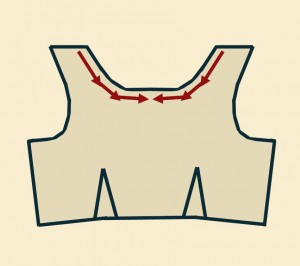Here’s a tip for you: I cannot stress enough the importance of staystitching. Patterns aren’t always clear about this crucial step, sometimes skipping it altogether—usually with disastrous results! Whether your fabric is woven or knit, all curved edges must be staystitched as a preliminary step.
What is staystitching? Staystitching is a line of regular straight stitching that stabilizes the fabric’s edge, so it won’t stretch during construction. It’s done within the seam allowance, so it won’t show. I usually use a slightly smaller stitch length than normal.
When should you staystitch? It must be done first thing, before you start pinning and sewing anything together. Handling the fabric, even just to pin the pieces, can result in unintended stretching. Then when you go to assemble your garment, you’ll find that pieces no longer match up. Or your neckline is suddenly a lot deeper than it should be.
Where should you staystitch? To be safe, staystitch any curved or bias edge that might potentially stretch during the sewing process. This includes necklines, contoured waistlines, armscyes, sleeve caps, and even shoulder seams. It’s done within the seam allowance, so it won’t show. If your allowance is a standard ⅝”, staystitch at ½”. If your allowance is ½”, staystitch at ¼”. You get the idea.
How do you staystitch? You’ll need to use a technique known as directional stitching, which is designed to minimize stretching, puckering, and distortion. Here’s a short guide (Directional Stitching), but basically, you sew from the highest point to the lowest point.
With a neckline, you’ll start at the shoulder edge and sew downward, following the curve to the center-front. Do not keep going up the other side! Stop sewing at the center -front. Flip the piece over and repeat what you just did, sewing from the shoulder down to the center-front.
Hopefully, you’ll find a lot less distortion and stretching once you incorporate staystitching into your sewing repertoire.


Is this the same way/time that flat lining is done? I keep encountering recommendations in my reading to flatline garments which I gather means another piece of fabric is cut and treated throughout assembly as integral with the top/fashion fabric but they are not clear on how or when it is attached and it doesn’t make sense to keep in two separate parts until the seams are sewn.
To flatline, you cut a second version of each piece out of a sturdy fabric. (What type of fabric will depend on the garment you’re making and the fashion fabric used.) Place the two layers together, with the flatlining on the wrong side of the fashion fabric. Baste around the edges, within the seam allowance. You’ll use the same method for basting as with staystitching or directional sewing, sewing from highest point to lowest, or widest to narrowest. Some fabrics demand hand basting, others work well with machine basting. As long as the fabrics lie flat against each other, without shifting or distorting, you’re fine. Once they’re basted together, treat them as one piece, sewing through all layers when stitching your seams. Hope this helps!
Yes, it does confirm that I was on the right track and puts in the steps that everyone assumes a sewer knows but that us beginners need spelled out. Thanks very much.